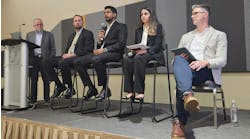By Jeff KoziolPutting intelligence at the point of entry keeps security systems simple and effective without sacrificing control. Computer-managed (CM) locking systems, which incorporate the controller, aren’t subject to network outages and system glitches. They are easier to install and set up – especially in existing, older buildings where it might be difficult to run network wiring.With today’s technology, on-board intelligence is easy to manage and update. Putting the decision-making function out at the door eliminates the need to maintain a central control panel in many cases. It shortens the link between the intelligence and the action. Where a facility does require a central computerized system, CM locking devices can augment the system for special areas that may not warrant hard wiring, as well as for building additions and limited-use sites.On-Board Intelligence Computer-managed locking systems come in many different types with different power sources and requirements, but all incorporate the intelligence necessary to make access control decisions right at the opening. Among the most common are locksets and exit devices with integrated access control trim. Close relatives include electric strikes, electromagnetic locks, and cabinet locks that may not have the controller imbedded within the actual product but in a common enclosure with the power supply that still makes it possible to mount the entire unit on a door without the need for network wiring.While not all such products include keypads, most offer keypad options that allow either PIN numbers as primary credentials or, in addition to magnetic stripe cards, proximity cards or electronic keys for secondary security levels.Software – Brains Behind the ProductsComputer-managed locking systems can’t take all the credit for their intelligence. An integral part of most standalone systems is the software that manages the data and provides the control template necessary to achieve multiple security goals. Individual locks and simple systems can often be programmed right at the keypad, but larger or more complex systems require the control and flexibility of computer programming. Well-written software provides the power that links systems together and enables an end-user to efficiently manage the facility and its security. While the intelligence may reside in the individual CM locking device on the door, it is the software that ultimately tells the lock who can enter and when.The software not only manages the information that the CM lock needs to recognize a particular credential and allow or deny access, it is the tool that makes it possible to establish time zones and schedules, collect and review audit trails, and set up various user groups and sub-groups. With software providing the link between multiple locations, facilities can program and collect audit trail data from individual openings on laptop or palmtop computers and unite it in a central master file.Most CM locking systems can be programmed either right at the locking device or through the use of a desktop, laptop, or palmtop PC. Generally, it is possible to associate a credential with a locking device, either manually or through computer programming.Access control system manufacturers provide software that enhances the performance of their products and their ability to function as a system. Some independent manufacturers also supply software programs for Windows®-based or other standardized systems.Jeff Koziol is product marketing manager at the Locknetics Division of IR Security & Safety (www.irsecurityandsafety.com), Forestville, CT.
Voice your opinion!
Voice your opinion!
To join the conversation, and become an exclusive member of Buildings, create an account today!
Sponsored Recommendations
Sponsored Recommendations
Latest from Smart Buildings
Latest from Smart Buildings
Sponsored
Sponsored

